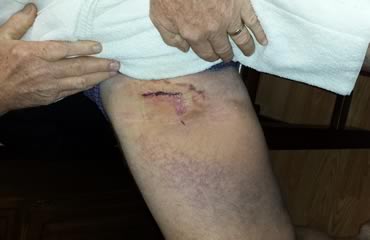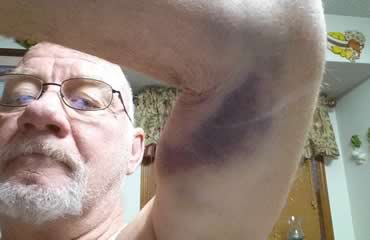If you ever wondered why TV hunters often poke a downed deer...
I went bowhunting at my favorite spot on the morning of October 26, 2015. I placed a doe decoy 20 yards from my treestand in hopes of luring a buck in close for a good shot.
At about 7:30, I saw a spike buck come out into the field and approach the decoy. We have a 4-point on one side rule in Missouri, so I just kicked back and watched the spike try to impress the doe decoy. He eventually gave up and went back into the woods.
A little while later I saw him again, only this time his attention wasn’t centered on the decoy. He couldn’t take his eyes off something else back in the woods. Hoping there was another buck, I strained my eyes until I finally made out a deer with antlers.
Figuring I’d better be ready in case the buck came in to check out the decoy, I stood and got ready for a shot.
I couldn’t believe my luck when the buck came walking in like it had read a movie script: ”Cue the buck walking in to decoy!”
As soon as I had a shot, I drew and released my arrow. The hit was a little farther back than I wanted, but I was confident it was a fatal shot.
 The deer ran into the woods and went out of sight. I waited 40 minutes before I got down to look for the blood trail.
The deer ran into the woods and went out of sight. I waited 40 minutes before I got down to look for the blood trail.
The blood was easy to follow, and perhaps I was a little overconfident, but the next thing I knew I jumped the buck. He took off, but it was obvious he wasn’t feeling too good.
After that I lost the trail a few times and decided to keep going the direction he had been headed — toward a big creek on the property.
Once there, I jumped him again, but he wasn’t able to go far and fell in the dry creek bed. When I approached, I noticed that he was still alive.
Assuming I was tracking a dead deer, I had left my bow back at the treestand. That was my first mistake.
Don’t ask what I was thinking when the little voice in my head said, ”Just sneak up and cut his throat with your knife.” The deer couldn’t even stand up, so how much of a fight could it put up, anyway? That was mistake number two.
I grabbed his antlers with my left hand and (I’m sorry for the graphic nature of this), made the slice. That’s when I learned the buck had a lot more energy and fight in him than I imagined.
The buck jumped up and immediately drove his antler high into my right thigh. His speed and strength were unbelievable — so much so that I dared not turn my back on him to run. I decided my best bet was to try to get control and pin him to the ground.
 I pushed his head back to get the antler out of my leg and immediately grabbed antlers with both hands and drove him to the ground.
I pushed his head back to get the antler out of my leg and immediately grabbed antlers with both hands and drove him to the ground.
I kept all of my weight on him and made sure to stay away from his hooves. About three minutes later the struggle was finally over.
Shaking badly, I stood up to try to assess the damage. The groin wound was about 3 1/2 inches long, but apparently it missed the femoral artery because it wasn’t bleeding much.
I dragged the deer to a cut bean field and then went to get my truck. Once I had the buck hanging in my backyard, I knew it was time to go to the emergency room and try to explain how I had been stabbed by a whitetail buck.
After 13 stitches and a countless number of funny looks later, the doctors sent me home.
As a veteran hunter, I should have known better than to approach a live deer. I guess it’s just an example of how easy it is to make a bad decision while under the effects of so much adrenaline. Never again will I track a deer without my bow or gun, and I won’t even consider approaching one until I’m sure it has expired.